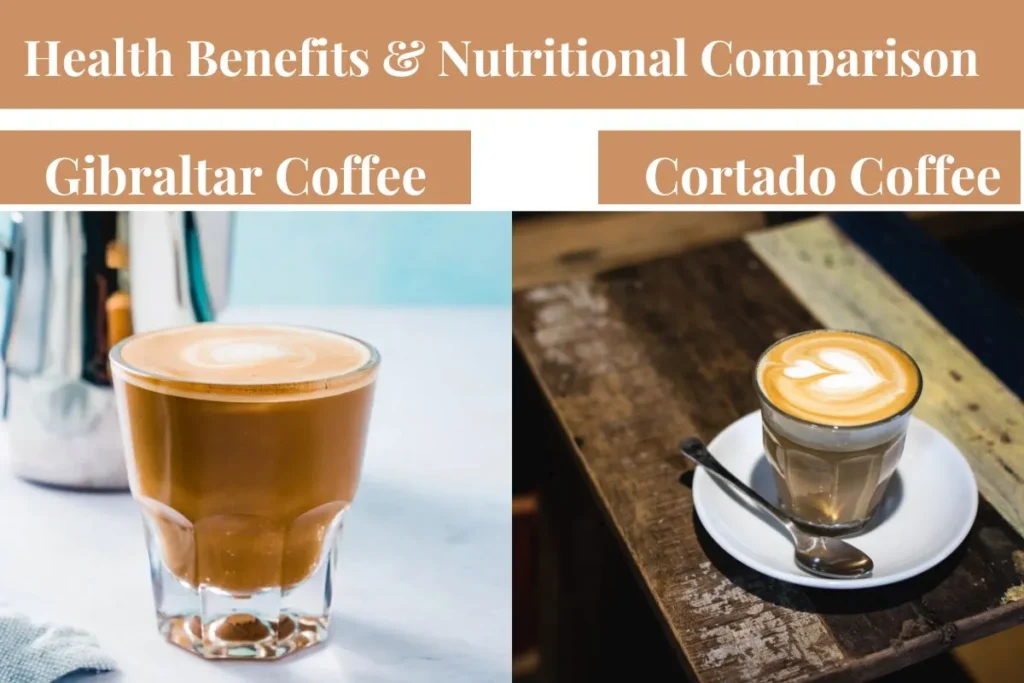Due to their similar appearances and ingredient lists, cortado and gibraltar coffee are two well-known coffee drinks that frequently cause confusion among coffee connoisseurs. We shall explore the history, composition, preparation techniques, flavor profiles, and cultural significance of Gibraltar coffee VS cortado in this post. You’ll know exactly what makes these two delicious coffee beverages different at the end.
Gibraltar Coffee Vs Cortado
| Aspect | Gibraltar Coffee | Cortado |
| Origin | San Francisco, 2005 | Spain, likely Basque region |
| Espresso to Milk Ratio | 1:1 (fixed) | 1:1 to 1:2 (variable) |
| Serving Size | 4.5 oz | 4-4.5 oz |
| Glassware | Libbey Gibraltar Glass | Varied (carajillo glass, ceramic cup, tumbler) |
| Serving Temperature | 150°F to 160°F (65°C to 71°C) | 140°F to 150°F (60°C to 65°C) |
| Flavor Profile | Bold, intense, pronounced acidity | Smooth, balanced, milder acidity |
| Caffeine Content | 60-80 mg | 50-75 mg |
| Texture | Full-bodied, velvety | Creamy, silky |
| Aroma | Strong initial coffee scent | Subtle, lingering aroma |
| Aftertaste | Lingering coffee flavor | Clean finish |
| Customization | Less flexible | More adaptable to preferences |
| Calories (approx.) | 50-70 | 50-70 |
| Antioxidant Content | Slightly higher | Slightly lower |
Origins and History
Gibraltar coffee emerged in an unexpected setting: San Francisco’s bustling coffee scene. In 2005, Blue Bottle Coffee Company inadvertently sparked a new trend when they acquired a large quantity of 4.5-ounce Libbey Gibraltar glasses. These vessels, initially deemed too small for standard coffee servings, became the catalyst for experimentation.
Baristas at Blue Bottle began crafting a unique beverage, combining a double shot of espresso with a splash of steamed milk. This creation, served in the distinctive Gibraltar glass, quickly gained traction among loyal customers. When patrons inquired about the drink’s name, it was spontaneously christened “Gibraltar” after its serving vessel.
James Freeman, Blue Bottle’s founder, described Gibraltar as a potent yet balanced espresso drink meant for immediate consumption. As Blue Bottle expanded across the United States, this innovative beverage gained popularity, eventually appearing on menus in coffee establishments worldwide.
In contrast to Gibraltar’s recent origins, cortado boasts a rich history deeply rooted in Spanish coffee culture. The term “cortado” derives from the Spanish verb “cortar,” meaning “to cut.” This name aptly describes the drink’s preparation, where steamed milk is used to temper the intensity of espresso.
While pinpointing cortado’s exact origins proves challenging, many sources agree it likely originated in Spain’s Basque region. Unlike many popular espresso-based beverages with Italian roots, cortado stands out as a distinctly Spanish contribution to the global coffee landscape.
Traditionally served in a small glass or ceramic cup, cortado embodies the Spanish approach to coffee consumption. It reflects a preference for balanced flavors and a smooth drinking experience, characteristics that have contributed to its enduring popularity in Spain and beyond.
As cortado gained international recognition, it has become a staple in coffee shops around the world. Its appeal lies in the harmonious blend of espresso and milk, offering coffee enthusiasts a perfectly balanced alternative to larger milk-based drinks or straight espresso shots.
Ratio of Espresso to Milk
The key distinction between Gibraltar and cortado coffees lies in their espresso-to-milk ratios, which significantly influence their flavor and drinking experience.
Gibraltar coffee typically maintains a strict 1:1 ratio of espresso to steamed milk. This equal proportion creates a harmonious balance, showcasing the espresso’s intensity while offering a smooth, velvety mouthfeel. A standard Gibraltar consists of:
- 2 ounces of espresso
- 2 ounces of steamed milk
This composition allows coffee enthusiasts to savor the espresso’s nuanced flavors without overwhelming the palate. The milk softens the espresso’s acidity, enhancing its sweetness and creating a well-rounded taste.
Cortado, on the other hand, exhibits more flexibility in its espresso-to-milk ratio. While traditionally prepared with equal parts espresso and steamed milk, variations exist. Common cortado ratios include:
- 1:1 – Equal parts espresso and milk (similar to Gibraltar)
- 1:2 – One part espresso to two parts milk
Some establishments may even adjust the ratio to 2:1, favoring a stronger espresso presence. This variability allows coffee shops to cater to diverse taste preferences and regional coffee cultures.
Flavor and Strength
The flavor profiles and strength of Gibraltar and cortado coffees differ significantly.
Gibraltar coffee presents a robust and intense flavor profile. The 1:1 espresso-to-milk ratio allows the espresso’s characteristics to shine, showcasing a rich complexity of nuanced flavors from the coffee beans.
Milk balances the espresso’s acidity, enhancing its inherent sweetness. Equal parts espresso and milk create a full-bodied, velvety texture. Gibraltar’s strength comes from its concentrated nature, packing a considerable caffeine punch ideal for those seeking a potent coffee experience.
Cortado offers a more adaptable flavor spectrum. Its traditional 1:1 ratio provides a smooth and balanced taste. Some variations with a higher milk content yield a creamier, silkier mouthfeel. The milk tempers the coffee’s intensity, allowing delicate flavors to emerge. Additionally, varying milk-to-espresso ratios can cater to individual preferences, offering a customizable strength. Cortado’s caffeine content typically falls slightly below Gibraltar’s due to potential increased milk volume, but this can vary depending on preparation.
In a comparative tasting, Gibraltar tends to retain more of the espresso’s natural acidity, while cortado often exhibits a milder, rounded acidity. Both drinks showcase natural sweetness from milk and espresso, but Gibraltar’s is more pronounced, while cortado’s may be subtler. Gibraltar leaves a lingering coffee flavor, while cortado often concludes with a cleaner finish.
The perceived strength of these beverages can vary. Gibraltar is consistently strong due to its fixed 1:1 ratio, while cortado’s strength ranges from moderate to high, depending on the milk-to-espresso proportion.
It’s important to note that the actual caffeine content remains relatively consistent in both drinks, as they typically use the same amount of espresso. The difference in perceived strength mainly comes from flavor intensity and milk dilution.
Glassware
The glassware used for serving Gibraltar and cortado coffees plays a crucial role in their presentation, temperature retention, and overall drinking experience.
Gibraltar coffee is inextricably linked to its namesake vessel, the Libbey Gibraltar Glass. This 4.5-ounce rock glass features a tapered, octagonal bottom and is designed with thick walls for insulation, a wide mouth for easy sipping, and a unique shape that enhances visual appeal.
The Gibraltar glass’s compact size is perfectly suited to the drink’s 1:1 espresso-to-milk ratio, while its sturdy construction ensures it can withstand the heat of freshly pulled espresso and steamed milk.
Cortado, with its Spanish origins, offers more varied serving options than its Gibraltar counterpart. Traditional Spanish establishments often use the carajillo glass, a small 4.25-ounce vessel.
In Latin America, cortados are sometimes served in small ceramic mugs, while glass tumblers, similar to but slightly taller and narrower than Gibraltar glasses, are also common. Regardless of the specific vessel, cortado serving sizes typically range from 4 to 4.5 ounces, reflecting the drink’s modest size.
Serving Temperature
The serving temperature of Gibraltar and cortado coffees significantly influences their taste, aroma, and overall drinking experience.
Gibraltar coffee is typically served at a slightly higher temperature, usually between 150°F to 160°F (65°C to 71°C). This higher heat intensifies the espresso’s robust flavors, allows for a gradual cooling process that reveals evolving taste notes, and provides a warming sensation appealing to those who prefer hotter drinks. The elevated temperature also releases a more potent coffee aroma upon serving.
In contrast, cortado is usually served at a lower temperature, often between 140°F to 150°F (60°C to 65°C). This cooler serving temperature allows for immediate consumption without the risk of burning, preserves the milk’s natural sweetness, and highlights the drink’s smooth, balanced flavor profile. Cortado’s cooler temperature also means its nuanced flavors can be savored immediately.
These temperature differences affect how the drinks are perceived. Gibraltar’s higher heat initially amplifies its boldness, while cortado’s lower temperature showcases a more consistent flavor from start to finish.
Gibraltar emits a stronger initial aroma, while cortado’s scent is more subtle but lingers longer. Additionally, Gibraltar’s heat can make it feel thinner initially, thickening as it cools, while cortado maintains a consistent, creamy mouthfeel throughout.
Caffeine Content
Understanding the caffeine content in Gibraltar and cortado coffees is essential for those monitoring their intake or seeking specific energy levels.
Both drinks typically start with a double shot of espresso, containing roughly 60-80mg of caffeine. However, subtle differences in preparation influence the final caffeine concentration.
Gibraltar coffee often maintains a higher perceived caffeine strength, ranging from 60-80mg. This is due to less milk dilution and a higher serving temperature, which may enhance caffeine absorption.
Cortado’s caffeine content typically ranges from 50-75mg, though this can vary. A higher milk content or regional preparation differences can slightly dilute the caffeine concentration.
Despite having a similar caffeine base, Gibraltar often feels stronger due to less milk and a higher temperature, while cortado may seem milder. Gibraltar’s higher temperature could lead to faster caffeine absorption, while cortado’s lower temperature and potential extra milk might slow it down.
However, both drinks typically provide a similar duration of caffeine effects, with individual metabolism and tolerance playing significant roles.
Health Benefits & Nutritional Comparison

Both Gibraltar and cortado coffees offer potential health benefits, primarily due to their espresso base and milk content.
Antioxidant Properties
Espresso, rich in polyphenols and chlorogenic acids, helps combat oxidative stress and inflammation, potentially reducing the risk of chronic diseases. Gibraltar, with its higher coffee-to-milk ratio, may offer a slightly higher concentration of these antioxidants.
Cardiovascular Health
Moderate coffee consumption has been linked to improved heart health, including blood pressure regulation and a reduced risk of stroke. Both Gibraltar and cortado, when consumed in moderation, may contribute to these benefits.
Cognitive Function
Caffeine in both beverages enhances mental performance, improving alertness and focus. Gibraltar’s potentially quicker caffeine absorption might offer more immediate cognitive effects.
Metabolic Benefits
Coffee consumption has been associated with increased metabolism and potential weight management benefits. The slight calorie difference between Gibraltar and cortado is negligible in terms of metabolic impact.
Nutritional Comparison
Milk in both drinks provides essential nutrients like calcium, protein, and vitamins. Cortado, with potentially higher milk content, may offer slightly more of these nutrients.
Considerations for Specific Diets
Gibraltar typically contains fewer calories, suiting low-calorie diets. Both can be made with plant-based milk for lactose intolerance or vegan diets.
Potential Concerns
Both drinks may cause jitters or sleep disturbances in caffeine-sensitive individuals. Espresso’s acidity might affect those with digestive issues, and added sugars can negate some health benefits.
Moderation is Key
Health benefits are associated with moderate consumption, typically up to 3-4 cups of coffee per day for most adults. Individual tolerance and health conditions should be considered.
Nutritional Comparison
While both Gibraltar and cortado can contribute to a healthy lifestyle when consumed in moderation, their specific health impacts may vary slightly due to differences in composition. The choice often comes down to personal taste preferences and individual health goals.
| Nutrient | Gibraltar (approx.) | Cortado (approx.) | Serving Size |
| Calories | 50-70 | 50-70 | 4-5 oz (120-150ml) |
| Fat | 3-4g | 3-4g | 4-5 oz (120-150ml) |
| Carbohydrates | <1g | <1g | 4-5 oz (120-150ml) |
| Protein | 4-5g | 4-5g | 4-5 oz (120-150ml) |
| Sugar | Negligible | Negligible | 4-5 oz (120-150ml) |
Conclusion
Gibraltar coffee and cortado offer coffee enthusiasts distinct experiences despite their similarities. Gibraltar coffee, known for its robust flavor and balanced coffee-to-milk ratio, appeals to those who prefer a stronger coffee taste in a smaller serving. On the other hand, the cortado charms with its silky texture and equal parts coffee and steamed milk, making it ideal for those seeking a smoother, more mellow coffee experience.
Frequently Asked Questions
Q1: What’s the main difference between Gibraltar and Cortado?
The primary distinction lies in their origins and espresso-to-milk ratios. Gibraltar has a fixed 1:1 ratio, while Cortado can vary from 1:1 to 1:2. Additionally, Gibraltar originated in San Francisco in 2005, whereas Cortado has deep roots in Spanish coffee culture. This difference in heritage influences not only their composition but also their serving styles and cultural significance.
Q2: Which drink is stronger?
Gibraltar typically tastes stronger due to its consistent 1:1 ratio and higher serving temperature, though actual caffeine content is similar. The perception of strength is also influenced by the temperature at which each drink is served, with Gibraltar’s higher heat amplifying its bold flavors. However, individual preferences and palate sensitivity can affect how “strong” each drink appears to different consumers.
Q3: Are Gibraltar and Cortado served hot or cold?
Both are served hot, but Gibraltar is usually slightly hotter (150-160°F) compared to Cortado (140-150°F). This temperature difference affects not only the immediate drinking experience but also how the flavors develop as the drinks cool. Some coffee enthusiasts enjoy experiencing the evolving taste profile of Gibraltar as it gradually cools, while Cortado offers a more consistent flavor throughout consumption.
Q4: How do the calorie counts compare?
Calorie content is similar, ranging from 50-70 calories per serving for both drinks. The slight variation in calories depends on the exact ratio of espresso to milk and the type of milk used. For those closely monitoring their calorie intake, opting for low-fat or plant-based milk can further reduce the calorie content without significantly altering the drink’s essence.

Rossi Glover, the passionate Owner of Grand Lake Coffee, infuses every cup with her love for coffee and dedication to quality. With an extensive background in the art and science of coffee, Rossi is not just a connoisseur but a storyteller, sharing the intricate tales behind each brew.
